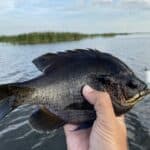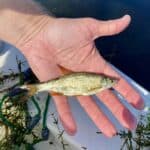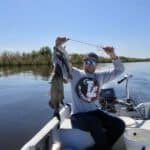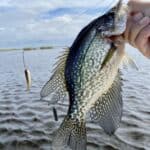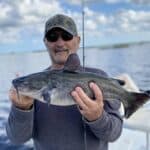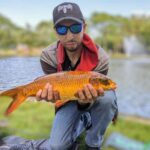Ice fishing for crappie at night can be a unique and rewarding experience.
If you love getting outside, crisp, cool temperatures, and eating the most delicious fish you’ve ever had, then ice fishing is the activity for you!
Crappie are incredibly active during the winter months and are one of the most coveted species within the ‘frost belt’ states.
Ice-fishing for crappie at night can be intimidating, but we’re here to tell you everything you need to know.
Read on for our favorite tips and tricks for this winter season!
Table of Contents
Ice Fishing For Crappie At Night
Ice fishing for crappie at night during the ‘hard ice’ months of January and February is a great way to target these tasty fish. During this time they become nocturnal, feeding heavily on minnows and insect larvae.
You’ll find them traveling in large groups in the winter months… and when you find one crappie, you’ll likely find hundreds of others nearby.
The best preparation for a night on the ice is to know and understand the lake you’re fishing.
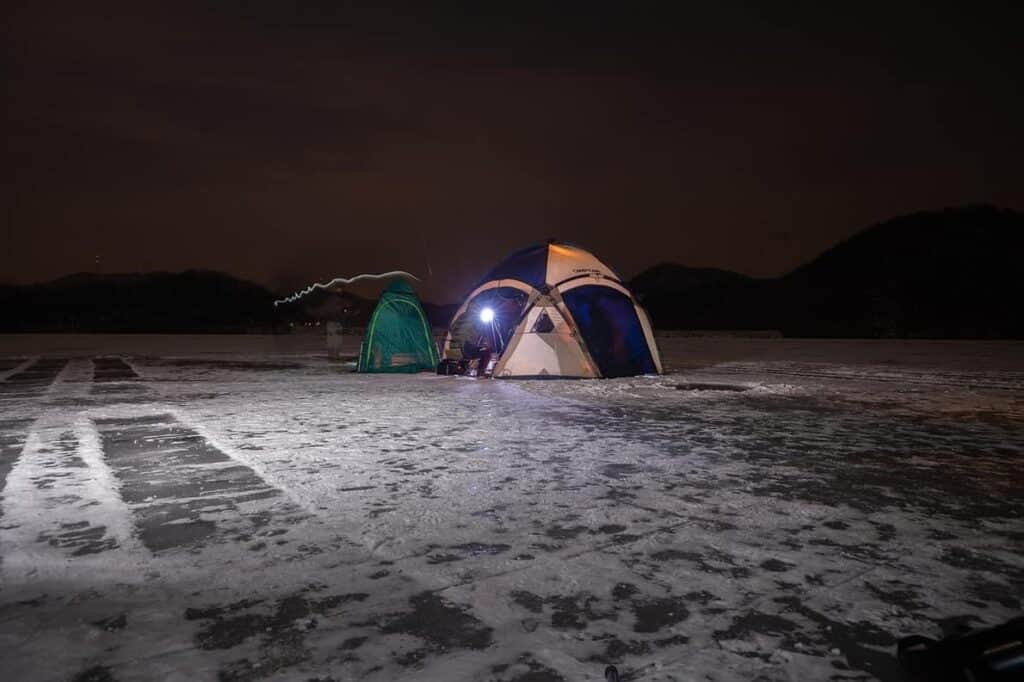
Having a general starting area will greatly increase your chances of being successful. If you’re fishing in a new area, call around to local bait and tackle shops…you may be surprised at how helpful they are.
Those same outcroppings that hold schools of crappie in the summer will be there after the ice forms. Pro tip: Mark your spots on your fish finder before the lake freezes and return to that location once the ice forms.
Submerged trees, rocky points near weed beds, channels, and other unusual structures attract and hold crappie.
Be sure to get out to the lake before sunset so you can get set up during daylight hours.
Ice Fishing Hole Patterns For Crappie
Once you’ve determined where you want to fish, you need to create a pattern for drilling holes. Many anglers just walk in a straight line, drilling holes every 10 feet or so.
This will work, but it’s not the best use of your resources, and at night, the furthest hole can be difficult to monitor.
A better method with night ice fishing is to locate a probable spot on the ice above a known crappie area. (Hopefully, one where you had success in the open water earlier in the season.)
Crappie move around a lot at night, so we recommend drilling multiple holes in varying positions to increase your chances of a bite.
Some anglers drill their holes on the edge of known feeding or staging areas, shallow weed beds, on the edge of the weed beds, or out in open water adjacent to weed beds.
When you’re over the structure, drill holes in a circular or star pattern with a radius less than 10 yards long from your central location. This will keep each hole closer to your location and make it much easier to monitor.
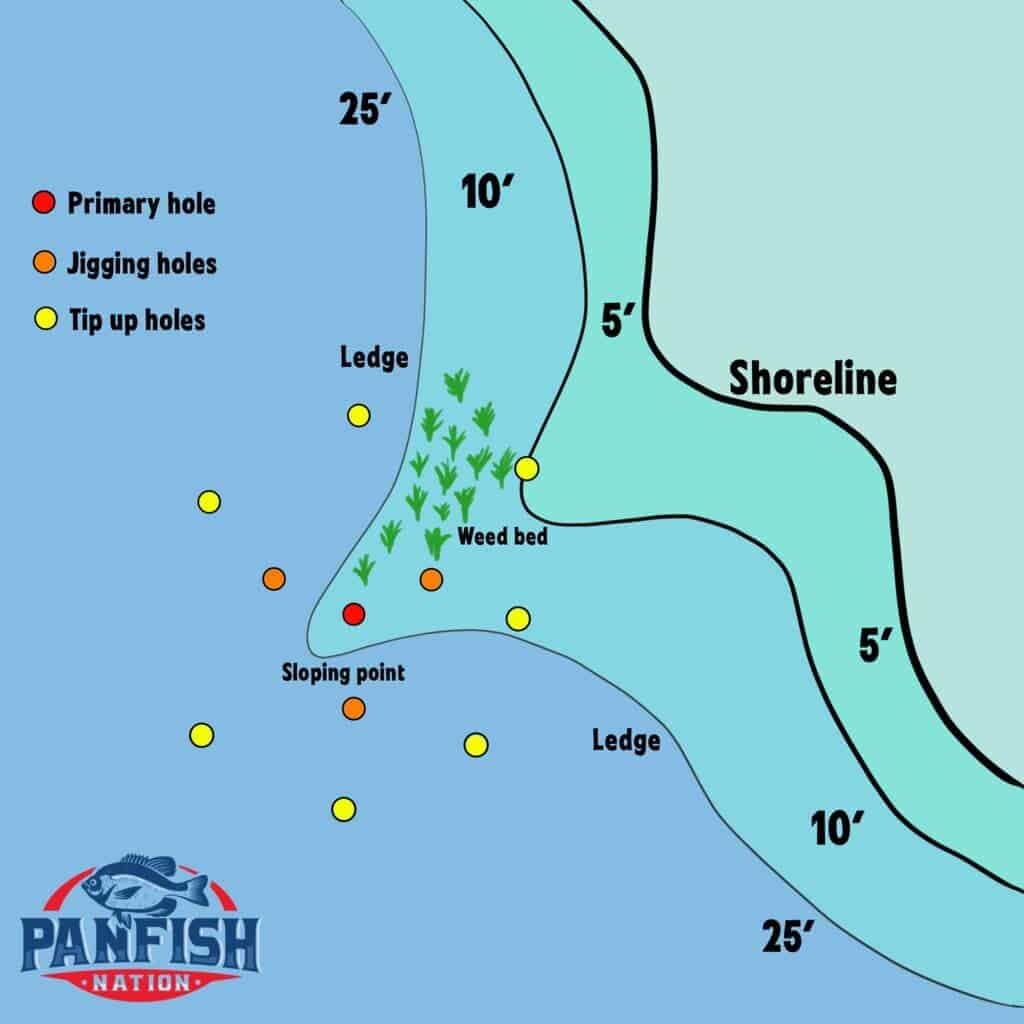
Using Lights Ice Fishing For Crappie At Night
Surface Lights
Surface Lights are those that stay above the ice and illuminate the area you are fishing, either directly on the ice or under your shelter. These can be effective to attract baitfish and are absolutely necessary to see and operate safely while fishing.
Submersible Lights
I highly recommend using a submersible light when ice fishing at night. They are easy to set up and you will be amazed at how much activity takes place around the light and the variety of fish it attracts.
Submersible Lights are waterproof and capable of being submerged under the ice to illuminate the water column below where you are fishing.
Typically these lights are plugged into a generator, or hooked up to a battery and lowered down into the water 10-30 feet below the surface.
Green is a very popular color because the color green penetrates through the water column spectrum without spooking fish.
These lights can be very effective because they attract zooplankton and microorganisms, which then attract smaller baitfish and eventually predatory fish such as crappie, walleye, and yellow perch.
Choosing The Right Crappie Baits
When it comes to choosing the right baits for crappie fishing at night, don’t overthink it. There are a couple of baits to use in the evening that will bring in crappie regardless of how much light is available.
Keep the bait size and profile as close as possible to the natural food crappie eat. Live bait can be very effective, but if it’s not available artificial lures and scented jigs can be just as effective.
Live Bait
Crappie love live minnows and if you can get your hands on them during the cold winter months, they are always a great choice.
Use your flasher or fish finder and suspend the minnows about 1 foot above the staging crappie. Tip them on jigs, try a dropshot rig or use a #8 Aberdeen wire hook.
Other live bait choices include freshwater shrimp, wax worms, mealworms, and nightcrawlers.
Artificial Bait
When fishing at night, use visible colored jigs like chartreuse, pink, or neon yellow. Glow jigs are very popular because they can be charged with a flashlight and will glow underwater.
Ice Fishing For Crappie At Night Tips & Techniques
Set your tip-ups to the outside of your circle, bait some of them with minnows, some baited with wax-worms and jigs, etc.
If all the action is on the minnow-baited rods, switch entirely to minnows. If they’re hitting on the waxworms, switch to that bait.
The key here is to diversify your baits, locations, and presentations until you find the fish!
For anglers who are not familiar with a lake, the white expanse of snow and ice doesn’t give many clues to what is lurking underneath. Technology can help!
Fishfinders work great in open water, they work equally as well through the ice.
Sophisticated models can pick up fish directly through the ice without drilling a hole, just set it on the ice, and take a few readings while walking around.
Other models such as flashers require a hole to be drilled first, then the fish finder is dropped through into the water.
Both of these will allow you to locate schools of fish.
The pattern and amount of fish on the screen will help you decide if they’re crappie, bass, trout, or perch. The more blips on the screen, the more fish and bait it’s picking up.
Ice Fishing at Night Regulations & Precautions
Pay close attention to the regulations in your area regarding the number of holes drilled through the ice, the number of tip-ups, or rods you can have in the water at once, and the legal bait you can use.
These regulations vary greatly from state to state, and even within the boundaries of a state they can be different in two lakes separated by just a few hundred yards.
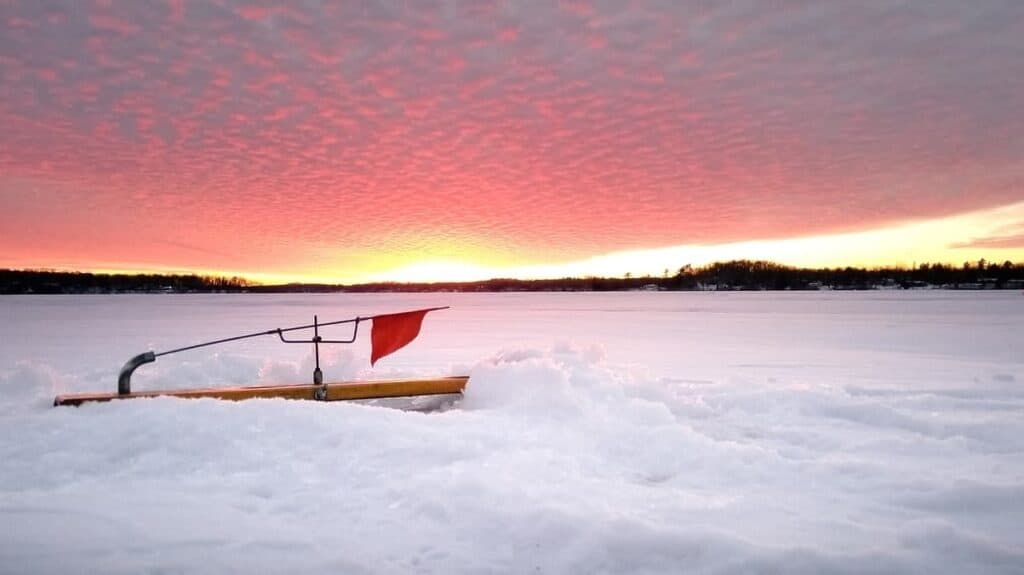
The ice should be at least four inches thick before you can safely walk on it. Take proper precautions when pulling in sleds, or carrying tackle boxes and buckets of supplies onto the ice.
Warm spots are common on lakes. Step in one, fall through the ice and you’re not going to have that awesome day catching crappie that you thought about all week.
Always be safe, and have a fishing plan and proper safety equipment on hand in case of emergencies.
Ice Fishing Sportsman Etiquette
Good sportsmen leave an area cleaner than they found it.
Police your fishing spot carefully as you pack up your gear, and load your catch onto the sled for the trek home.
Don’t leave foam nightcrawler containers, empty bottles, cans, or food wrappers on the ice.
Ice Fishing for crappie at night is fun, exciting, and a great way to target these tasty fish.
Follow the basic guidelines I outlined in this article, experiment with your setup locations and you’ll be catching fish in no time.
Thanks for reading!
See Also: Ice Fishing Reel vs Regular Fishing Reel…What’s The Difference?
If you haven’t guessed yet, I love fishing and everything about it!
To learn more about why I started Panfish Nation, visit the About page and follow along on Social Media:


Download a copy of my FREE Lure Color Selection Chart & Knot Guide!
Stay up to date with fishing reports, tackle reviews, industry news, and much more! We respect your privacy, unsubscribe at any time.
Related Posts
- How To Hold A Bluegill: Tips and Best Practices
- How To Catch Wild Shiners For Bait (Step By Step W/Pics)
- How To Use A Fish Stringer (Easy Explanation W/Tips)
- How To Keep Minnows Alive Without an Aerator (7 Tips)
- Why You Should Be Using Kool-Aid As Catfish Bait!
- How to Catch Koi Fish (And Are They Edible?)

